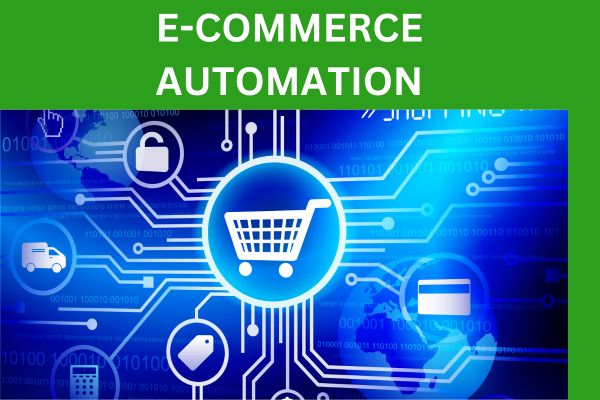E-commerce automation software refers to a suite of tools and technologies designed to streamline and automate various aspects of online business operations. It aims to simplify repetitive tasks, improve efficiency, reduce errors, and ultimately enhance the overall performance of e-commerce businesses. These software solutions typically integrate with e-commerce platforms, payment gateways, inventory management systems, customer relationship management (CRM) software, and other relevant systems.
Benefits of E-commerce Automation Software
Increased Efficiency: Automation eliminates the need for manual intervention in routine tasks, saving time and reducing errors.
Enhanced Customer Experience: Automation enables faster order processing, personalized marketing campaigns, and seamless customer support, leading to improved customer satisfaction.
Scalability: E-commerce automation software facilitates the efficient handling of growing order volumes and business expansion.
Inventory Management: Automation helps optimize inventory levels, reduce stockouts, and automate replenishment processes.
Order Fulfillment: Automated order fulfillment processes ensure accurate picking, packing, and shipping, resulting in faster delivery times.
Marketing Automation: E-commerce automation software enables personalized marketing campaigns, abandoned cart recovery, and customer segmentation.
Data Analysis: These tools provide valuable insights through data analytics, enabling businesses to make informed decisions and optimize strategies.
Key Features of E-commerce Automation Software
Order Management: Automated order processing, tracking, and fulfillment.
Inventory Management: Real-time inventory tracking, stock level alerts, and automated replenishment.
Customer Relationship Management: Customer data management, personalized marketing campaigns, and customer support automation.
Shipping and Logistics Integration: Seamless integration with shipping carriers and logistics providers for efficient order fulfillment and tracking.
Marketing Automation: Email marketing, abandoned cart recovery, customer segmentation, and personalized recommendations.
Reporting and Analytics: Comprehensive reporting and data analytics to gain insights into sales, customer behavior, and overall business performance.
Integration Capabilities: Ability to integrate with e-commerce platforms, payment gateways, CRM systems, and other relevant tools.
How to Choose the Right E-commerce Automation Software
Identify Business Needs: Determine which specific processes and tasks require automation and assess the scalability requirements.
Compatibility: Ensure the software integrates seamlessly with your existing e-commerce platform, payment gateways, and other essential systems.
Ease of Use: Look for user-friendly software that can be easily adopted by your team without extensive training.
Customization: Consider software that allows customization to align with your unique business requirements.
Support and Maintenance: Evaluate the level of technical support, regular updates, and ongoing maintenance provided by the software vendor.
Pricing: Compare pricing models and consider the software’s return on investment (ROI) in terms of efficiency gains and business growth.
Top E-commerce Automation Software Solutions
Solution 1: [Software A] – This robust automation software offers comprehensive features for order management, inventory control, marketing automation, and analytics.
Solution 2: [Software B] – With a user-friendly interface and seamless integration capabilities, this software streamlines order processing, inventory management, and marketing automation.
Solution 3: [Software C] – Designed for scalability, this software provides advanced features for order fulfillment, inventory optimization, and personalized marketing campaigns.
Implementing E-commerce Automation Software: Best Practices
Plan Ahead: Define your automation goals, outline implementation timelines, and allocate resources accordingly.
Data Migration: Ensure smooth data transfer from existing systems to the new automation software, maintaining data integrity.
User Training: Provide comprehensive training to your team members to familiarize them with the software’s functionalities and processes.
Test and Iterate: Conduct thorough testing and iterate based on feedback to optimize the software’s performance and alignment with your business processes.
Monitor and Measure: Continuously monitor key metrics and performance indicators to assess the effectiveness of the automation software and identify areas for improvement.
Case Studies: Successful Implementation of E-commerce Automation Software
Case Study 1: Company X – By implementing e-commerce automation software, Company X achieved a 30% reduction in order processing time and a 20% increase in customer satisfaction.
Case Study 2: Company Y – Company Y experienced a significant improvement in inventory accuracy and a 25% decrease in stockouts after adopting e-commerce automation software.
Challenges and Limitations of E-commerce Automation Software
Initial Investment: The cost of implementing e-commerce automation software can be a barrier for small businesses.
Integration Complexity: Integrating the software with existing systems and platforms may require technical expertise.
Learning Curve: Employees may require training and time to adapt to the new software, affecting productivity initially.
Customization Constraints: Some software solutions may have limitations in terms of customization to fit specific business needs.
Future Trends in E-commerce Automation Software
Artificial Intelligence (AI) and Machine Learning (ML): AI and ML technologies will play a significant role in enhancing automation software capabilities, enabling intelligent decision-making and predictive analytics.
Voice Commerce: Voice-enabled devices and voice recognition technology will be integrated into e-commerce automation software, providing a seamless voice-based shopping experience.
Hyper-Personalization: Automation software will leverage advanced customer segmentation and personalization techniques to deliver highly targeted marketing campaigns.
Robotics Process Automation (RPA): RPA will further automate manual tasks, enabling businesses to achieve higher levels of efficiency and cost savings.
What is e-commerce automation software?
E-commerce automation software refers to tools and technologies that automate various aspects of online business operations, such as order processing, inventory management, and marketing campaigns.
How can e-commerce automation software benefit my business?
E-commerce automation software can increase efficiency, enhance customer experiences, streamline inventory management, optimize order fulfillment, and enable personalized marketing campaigns.
What features should I look for in e-commerce automation software?
Key features to consider include order management, inventory management, customer relationship management, shipping and logistics integration, marketing automation, reporting and analytics, and integration capabilities.
How do I choose the right e-commerce automation software for my business?
Consider your business needs, compatibility with existing systems, ease of use, customization options, support and maintenance, and pricing when choosing e-commerce automation software.
What are the future trends in e-commerce automation software?
Future trends include the integration of AI and ML technologies, voice commerce, hyper-personalization, and the adoption of robotics process automation.




